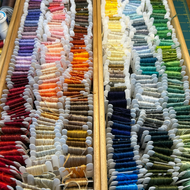My Felting Toolbox: The Supplies That Bring Creatures to Life
Posted by Emily Bradley, Artist Altitude Artworx- A Felt Art Studio on Sep 23rd 2025
My Felting Toolbox: The Supplies That Bring Creatures to Life
Every artist has their favorite supplies—the ones they reach for without thinking, the tools that feel like an extension of their hands. For me, felting is as much about the materials I choose as it is about the stitches and stabs of the needle. Each supply has a story, a reason, and a little quirk of its own.
Wool Felt: The Foundation
I work with 100% wool felt sourced from a wholesale supplier. It comes in a rainbow of colors, and each sheet is like a blank canvas waiting to be sculpted. Wool felt is strong, flexible, and natural—it’s the layer that holds the shape together before I begin building details.
Baling Wire: Bones From the Farm 
Living in farm country, I’m surrounded by baling wire. It’s abundant, sturdy, and it just makes sense to use what’s right outside the door. I shape the wire into armatures—the skeletons of my creatures. To keep the natural oils in the wire from contaminating the wool, I wrap it before layering on fiberfill and felt. It’s a farm-born material with a studio twist.
Fiberfill: The Core
Inside each sculpture, I use a cotton-polyester fiberfill blend. I’ve tested pure cotton and pure synthetic, but neither worked the way I needed. This blend provides just the right firmness while still letting the felting needle grip and shape the wool. It’s not glamorous, but it’s essential.
Raw Wool: Character in Every Fleece
I love working with the natural colors of wool—browns, creams, greys. Llama fiber, coarse sheep hair, and fleeces often overlooked by others are my favorites. They have texture, personality, and life. The best wools, for me, are the ones nobody else wants. I do buy them cleaned; I’ve washed fleece myself, and let’s just say endless rounds of “washing and washing and washing” aren’t my idea of fun.
Needles: Tiny but Mighty
For each sculpture, I’ll go through two to three star-head small needles. They break—it happens. When they do, I just remove the broken barb and keep going. The rhythm of stabbing and shaping is what turns loose fibers into something solid.
Threads and Scissors: The Finishing Touches
DMC floss is one of my favorite accents. It has a lovely shine, comes in endless colors, and adds that little glimmer where wool alone can’t. Sharp scissors, both large and small, are non-negotiable. They’re the difference between clean details and fuzzy chaos.
Pins: The Unsung Heroes
Finally, pins—lots of pins. I use them as placeholders for eyes, to hold fleece in position, or to mark where something should sit before I commit with the needle. They’re simple, but they make the process a lot less like guesswork and more like guiding.
Each of these supplies plays its part. From baling wire pulled from farm country to overlooked fleeces that find a second life in wool form, they all come together to build the whimsical characters that step out of my studio.
